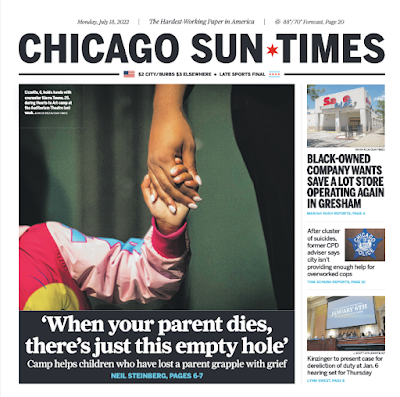 |
| Voltaire, by Jean-Antoine Houdon (National Portrait Gallery) |
You never know what is going to stick in a reader's mind. After a colleague approvingly retweeted my Wednesday column on Loredo Taft's "Fountain of Time" scupture, a Twitter follower observed that while I am a readable fellow, a certain aesthetic opinion I expressed 12 years ago diminishes everything I've written since. I immediately checked the original he quoted from, and found this review, which I think bears re-reading. I'll let you guess which opinion indicted me, in his eyes, and tell you after.
If I had to point to one single historical episode to explain the entire human condition, I would highlight the little-known fact that a number of survivors of the atomic bomb dropped on Hiroshima Aug. 6, 1945, fled to Nagasaki in time for the second bomb dropped three days later.
This out-of-the-frying-pan-into-the-fire quality, so horrible that it becomes comic — at least when happening long ago to people far away whom you don't know — flashed as I sat in the Goodman Theatre Monday for opening night of "Candide."
Leonard Bernstein's 54-year-old musical version of Voltaire's 250-year-old satire should not feel current. But something about its deep cynicism, its chain of self-interested rogues, puffed up rulers and luckless victims, makes it perfect for these times, when we stumble from natural disaster to pointless bloodletting to political upheaval. The randy Jesuits Voltaire parodies, well, let's say they did not have the dust of the ages upon them.
I loved it.
Then again, I'm an odd mix of deep cynicism and childlike innocence. I enjoyed the way the play's characters were casually butchered, its cities destroyed, sailors drowned, maidens defiled, all with director Mary Zimmerman's full palette of cute theatrical devices — ships on sticks, stoic red toy sheep, ribbons as blood — sugar-coating the three hours of musical mayhem. How many plays are there where the line "Throw the Jew into a ditch" draws a hearty laugh from the audience?
For those unfamiliar with the story, Candide is a pleasant young simpleton who gets evicted from the idyllic palace where he was raised. He's forced to wander our world of endless outrage, misery and atrocity, searching for his lost love, Miss Cunegonde (played with show-stealing zest by Lauren Molina).
No experience, no matter how awful, blunts Candide's optimism — I hate to say it, but he is very Barack Obama-ish in his tendency to place his trust in obvious enemies and his reluctance to let a steady rain of betrayals dampen his worldview.
'A CHAIN OF ASTONISHING CALAMITIES!'
The music, alas, is not memorable. Bernstein wrote it, but "West Side Story" this ain't. Though when you have lyrics like "What a day for an auto de fe!" who cares about melody? Several of my associates, more experienced theatergoers than myself, complained that Zimmerman's bag of stage tricks has grown stale, so maybe enjoyment reveals a Candide-like naivete on my part. But how could you not love a musical with a number celebrating the transmission of venereal disease, sung by a character with a silver nose? ("Untreated syphilis destroys the cartilage in your nose," I explained to my 14-year-old, eager to show off knowledge that I never thought I'd have the chance to use. "People really did wear those noses.")
That either intrigues or repels you. Now that every new musical seems designed to help 12-year-olds feel good about themselves, it's bracing to be reminded that theater used to be something adults did to make our scary world seem less so.
A few who fled Hiroshima to Nagasaki survived both, by the way, living to face life's fresh horrors. Which is the message of the play. You survive; well, some do.
—Originally published in the Sun-Times, Sept. 29, 2010
It was the backhand to the melodies of Leonard Bernstein that stuck in his craw, a judgment he found "stupid." To me, there's no accounting for taste, but I do know that others hold their own opinions so highly they come to believe they're absolutes. They're not. If you prefer Salieri to Mozart, well, I would not want to imitate the monks Voltaire decries who "who burn people that are not of their opinion."








